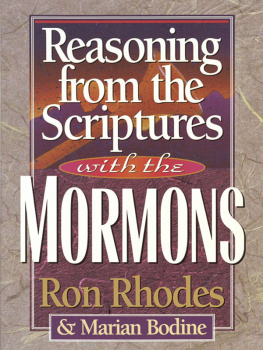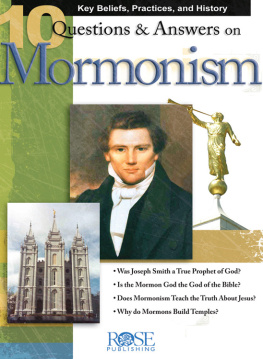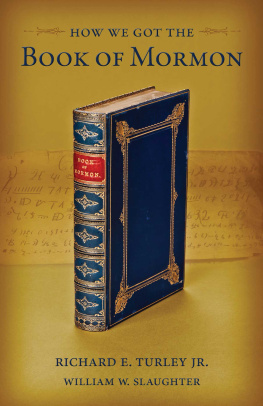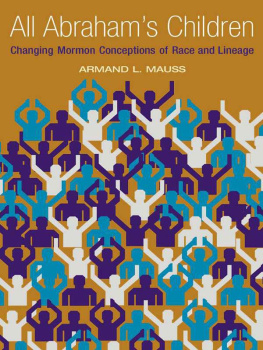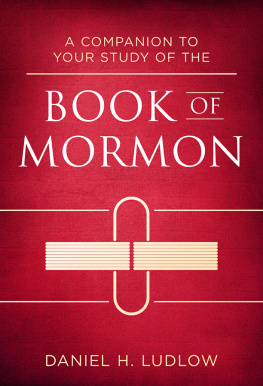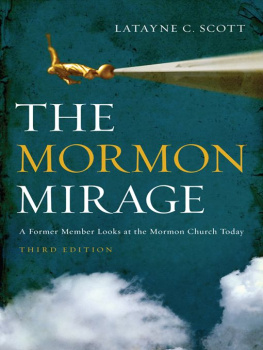COPYRIGHT 2019 BY THE UNIVERSITY OF UTAH PRESS. ALL RIGHTS RESERVED.
Names: Rogers, Jedediah S. (Jedediah Smart), 1978 editor. | Godfrey, Matthew C., editor.
Title: The earth will appear as the Garden of Eden : essays on Mormon environmental history / edited by Jedediah S. Rogers and Matthew C. Godfrey.
Description: Salt Lake City : The University of Utah Press, [2018] | Includes bibliographical references and index. |
Identifiers: LCCN 2018030659 (print) | LCCN 2018032522 (ebook) | ISBN 9781607816546 | ISBN 9781607816539 (pbk. : alk. paper)
Subjects: LCSH: EnvironmentalismReligious aspectsChurch of Jesus Christ of Latter-day SaintsHistory. | EnvironmentalismReligious aspectsMormon ChurchHistory. | Zion (Mormon Church) | Ecotheology. | EnvironmentalismUtahHistory. | EnvironmentalismWest (U.S.)
Classification: LCC BX8643.Z55 (ebook) | LCC BX8643.Z55 E27 2018 (print) | DDC 261.8/80882893dc23
The Earth Will Appear as the Garden of Eden is taken from the Mormon hymn Now Let Us Rejoice by William W. Phelps, which was first included in the LDS hymnbook in 1835.
Printed and bound in the U.S.A.
INTRODUCTION
The Promise and Challenge of Mormon Environmental History
Jedediah S. Rogers and Matthew C. Godfrey
DESPITE ITS LONG-ESTABLISHED PRESENCE in the academy, the perspective of environmental history has made few inroads into Mormon studies. This is true even as dozens of high-quality works on Mormonism appear annually; Mormon studies has perhaps never enjoyed more vitality. This is not to say that writers have ignored environmental themes, but the historians and scholars consciously examining Mormonism within the academic stream of environmental history have been few and are generally not recognized by the field.
This is surprising given the prominence of environmental history in the academy and the subsequent way insights from the field have seeped into the literature. Like the new Mormon history, environmental history developed as a subfield in the milieu of the new social historyhistory from the bottom up. Concerned as its practitioners were with the lives of ordinary people as well as the dynamics of gender, race, and ethnicity, environmental historians added nature as an active actor to the stories they told. The historical subfield developed alongside the American environmental movement of the 1960s and 1970s. Many of its practitioners, then and now, came to it through their own environmental awarenessa personal connection to the natural world and a commitment to protect it from despoliation. At the same time, historians who embraced this burgeoningfield brought to their studies a methodological rigor that drew on the insights of historical geography, cultural ecology, and other disciplinary schools.
From the beginning, environmental historians examined nature as a category of analysis and situated it within the just as amorphous category of culture. Early contending positions centered in one sense on the difference between seeing nature as an autonomous entity with its own set of values independent of humans or, unavoidably, as a product of cultureof human values and assumptions.
However they define the nature-culture relationship or speak of nature as an agent similar to humans, environmental historians recognize nature as a vital forceone that acts on the human dominated world and that is unavoidably transformed by human activity. Environmental historians long recognized that while nature once largely set the terms of life, humans have continually modified, altered, and affected it. People have always stood in relation to nature. But the terms of that relationship have fundamentally changed with the Industrial Revolution and the attendant burgeoning population and capitalist economy. In the estimation of the historian Donald Worster, this made the nineteenth century distinct from the eighteenth, giving rise to environmental prophets like George Perkins Marsh, who lamented the destructive force of human society on the environment.
In recent years, scholars have also increasingly investigated the impact of religion and religious movements on nature. Lynn White Jr., for example, The connection between religion and nature is a burgeoning field, making the time ripe to examine Latter-day Saints and their past through the lens of environmental history.
Mormonism was born and matured during the past two centuries of industrialization, capitalism, and environmental change. From the beginnings of the church, its members interacted with nature in significant wayswhether perceiving it as a place to find God (as Joseph Smith did by going into a grove of trees to offer the prayer that put into motion his work as a spiritual leader), as a place to build communities that would usher in the Second Coming, or as a place brimming with natural resources they could use to further their economic well-being. One way to examine Mormon environmental history is to see it as a tale of environmental declension, both in perception (the theological shift away from salutary agrarianism) and practice (the transformation attendant with Mormonisms incorporation into American consumer culture). This sense of loss and decline is an important component of the environmental history of Mormonism, but there are multiple other ways of reading the environment in the Mormon past. We open with a reflection by Jedediah S. Rogers on the themes and tools of environmental history in Mormon historiographyhow the terms nature and environment have variously been employed in traditional Mormon history, the catalog of works addressing Mormon themes, and the challenge and revisions environmental history offers to a study of the Mormon past. He shows how geographers and scholars from disciplines outside of history have traditionally taken the lead when examining environmental themes in Mormon country. Despite the relative paucity of historical works on Mormonism and the environment, a handful of texts in recent years represent the promise of the field.
The other essays are organized according to divisions generally characteristic of the fieldi.e., representing ideas and perceptions about nature, Theology and Ideology, offer contextualized histories of Mormon environmental thought, demonstrating the complexity of applying a nature-based theology in the nineteenth- and twentieth-century West. We begin with Sara Dants reflections on the environmental ethic of Brigham Young, the influence such thinking had on Latter-day Saints, and how the Utah Mormons drifted away from Youngs notions as they became more fully integrated into the nation and the economy. The next essay, by Thomas G. Alexander, argues that the Mormon de-emphasis of nineteenth-century environmental teachings during the twentieth century was an act of forgetting in the face of what he calls secular entrepreneurship. The shift to secular entrepreneurship not only resulted in the abandonment of a pioneer environmental ethic but also major landscape transformations. Both essays demonstrate a common theme in the field of environmental history: that myths, beliefs, and ideas about nature are fluid and have on-the-ground consequences.
These essays also suggest a deep association of Mormons to a particular place: the valleys, mountains, and deserts of the Great Basin. In , Perception and Place, the essays bring more specificity to the Mormon connection with what Wallace Stegner called Mormon Country and Donald Meinig referred to as the Mormon cultural region, as well as expound on the connection between Mormonism and other environments. A strength of environmental history is its attention on place and place-makingon the richly textured examinations of people and groups interacting in particular locales. Consider the first two selections in this section: Matthew C. Godfreys examination of environmental language in Jackson County, Missouri, and Brett Dowdles investigation of foreign environments. Godfrey challenges traditional understandings of early Mormon identity and conflict by detailing Mormon thought and interaction in Missouri. Dowdle, meanwhile, explores the complex environments of Great Britain and Nauvoo, Illinois, showing not just how early Mormon missionaries and converts perceived and acted in these places but also how these places in turn acted on their worldviews and even theology.



